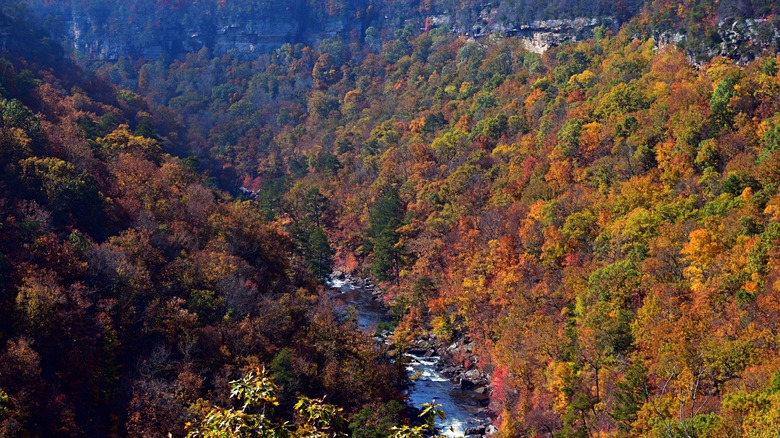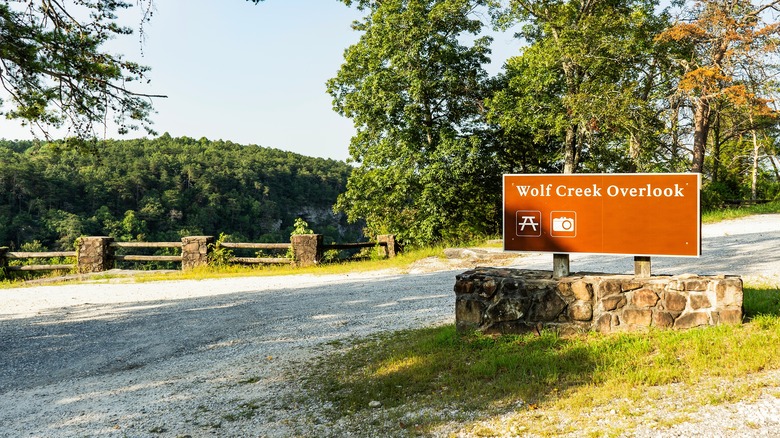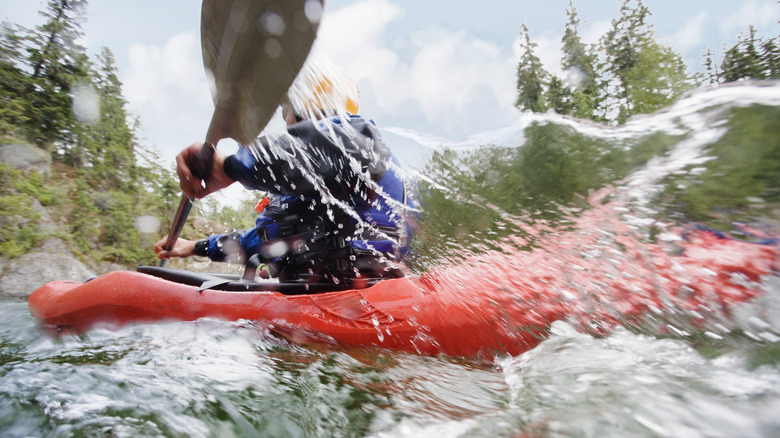Head To This Southern Park For Beautiful Fall Foliage And Waterfall Views
There's nothing like the crisp air of fall to get you in the mood for some well-deserved outdoor adventures. From budget-friendly vacation spots perfect for a fall getaway to leaf-peeping scenic drives and hitting up some picturesque hiking trails, fall is the perfect time to explore the most vibrant landscapes — courtesy of nature's annual color show. However, away from the crowded hotspots and bucket list-worthy fall views of the northeast, there are plenty of destinations further south that'll still deliver in terms of autumn-coded beauty. One of these is the Little River Canyon National Preserve.
Nestled in the heart of northeastern Alabama — and hailed as one of the best national parks in the South —the Little River Canyon National Preserve encompasses all of the natural beauty and outdoor adventure you could hope for in the Southern Appalachians. A hidden gem brimming with rugged cliffs, dense forests, and cascading waterfalls, the park offers a perfect escape for nature lovers and thrill seekers alike.
Officially established in 1992, the preserve protects over 15,000 acres of stunning landscapes centered around Little River Canyon. This impressive gorge — carved by the Little River over millions of years — stretches more than 600 feet deep in some areas, making it one of the deepest canyon systems east of the Mississippi. So whether you're dreaming of scenic overlooks or hoping to test your mettle with challenging hiking trails, Little River Canyon National Preserve promises an unforgettable fall experience that'll rival any New England destination.
Enjoying the views at Little River Canyon National Preserve
Little River Canyon National Preserve packs a punch when it comes to fall activities. The 11-mile scenic drive along Highway 176 is a good place to start. With eight overlooks offering views of the canyon, rock walls, and river below, you'll have plenty of opportunities to enjoy unspoiled views of the trees' red, orange, and yellow hues — all without battling the crowds you'd typically find up north.
Additionally, the preserve is also home to three impressive waterfalls — the most popular being Little River Falls. Standing at 45 feet tall, the waterfall packs a punch in terms of natural beauty and raw power. Located near the Little River Canyon Visitor Center — and just off Highway 35 — it's a must-see stop while exploring the park. However, keep in mind that, during the fall, the waterfall's volume might flow a little lower than usual. Nonetheless, despite the reduced flow, it's always important to exercise caution. This includes staying at least 50 feet back from the edge and not climbing over any barriers.
Rounding out the list, there's also Little Falls — which offers a scenic spot accessible via a 0.75-mile trail from the Little River Falls parking lot — and the seasonal Graces High Falls (depending on rainfall) — Alabama's tallest above-ground waterfall at 133 feet, which also features a viewing platform.
More activities to enjoy at Little River Canyon National Preserve
Alternatively, if you're an avid hiker, you'll also be happy to know that the preserve boasts over 26 miles of trails ranging from easy walks by the river to tougher hikes that lead all the way down into the canyon. Some of the most popular routes include the Bridge Trail (which covers 0.75 miles out and back), Beaver Pond Trail (1.5-mile loop), YCC Loop Trail (3.75-mile loop), and the Eberhart Trail (a 0.75-mile arduous trek into the canyon). As a plus, birdwatchers can even spot some migratory species, including hawks, passing through during the fall, in addition to the usual local birds. Along with this, the preserve's 20 miles of backcountry roads — also accessible to horseback riders, four-wheel vehicles, and mountain bikers — are also a treat.
On the river, fishing enthusiasts can cast their lines pretty much anywhere along Little River within the preserve — as long as they have a valid fishing license. And while fall water levels might be lower than usual, you'll be glad to know that kayaking and canoeing are still possible for skilled paddlers — especially in the upper stretches of the river. Just remember that motorized boats aren't allowed on the water as part of the wildlife authorities' mission to protect the endangered blue shiner.
Lastly, for visitors looking for more of an adrenaline rush, the preserve is also known for its rock climbing. Home to some of the most difficult climbing routes in the South, the preserve is well-known to enthusiasts for its famous "concave wall," which features challenging 5.13- to 5.14-grade routes.


